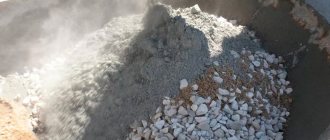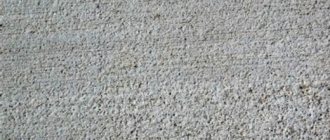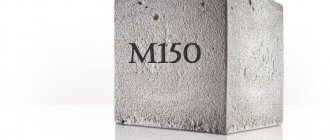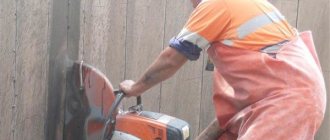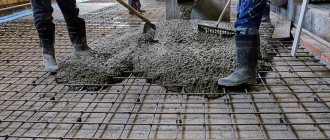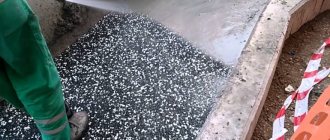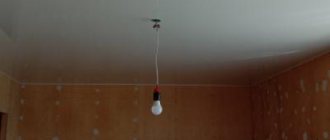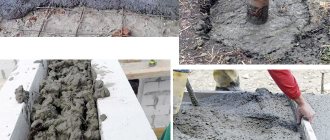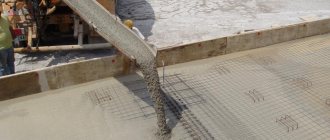Lightweight concrete, characterized by a relatively low average density (500-800 kg/m³) and high porosity (up to 40%), is currently widely used for the manufacture of enclosing and load-bearing reinforced concrete and concrete structures. If lightweight concrete is used instead of brick and heavy concrete, it becomes possible to significantly increase the thermal insulation characteristics of fences, which makes it possible to reduce the weight and thickness of the walls of buildings and thereby reduce transportation costs.
Lightweight concrete is used in the construction of low-rise buildings and fences.
Types of light solutions
Crushed stone from volcanic slag, pumice, volcanic dolomite and porous limestone, calcareous tuff, shell limestone, tripoli, opoka, fuel cob, diatomite, porous metallurgical slag, perlite, thermosite, vermiculite, etc. are used as aggregates in lightweight concrete.
Depending on what type of coarse porous aggregate the concrete was made with, it is divided into slag concrete, aggloporite concrete, expanded clay concrete, pumice concrete, etc.
According to their structure, they are divided into the following types:
The thermal protection of lightweight concrete is several times higher than that of brick, although the cost is much cheaper.
- ordinary ones, which are made from a binder, coarse and fine aggregates, and water. The amount of air involved in the mixture does not exceed 6% of the total volume;
- sandless (large-porous), in which the grains of coarse aggregate are covered with a thin layer of cement paste, while the intergranular voids remain free. The large-porous structure includes over 25% of voids filled with air;
- porous based on a blowing agent and a binder. Stifling cells are formed in the structure of such materials. Due to this, the porosity of the cement mortar increases, which reduces the density of the building mixture.
According to their purpose, porous aggregates are divided into several types:
- thermal insulation - the average density in an air-dry state is less than 500 kg/m³, and thermal conductivity is not higher than 0.25 W/(mx°C). Used for the manufacture of thermal insulation boards and other products;
- structural and thermal insulation with an average density of up to 1400 kg/m³, thermal conductivity not higher than 0.6 W/(mx°C) and strength not lower than M35. Used in self-supporting and load-bearing enclosing structures (ceilings and walls);
- structural - average density 1400-1800 kg/m³, strength not less than M50, frost resistance from F15. Used in load-bearing structures.
Based on the type of binding materials, lightweight concrete can be lime, cement, gypsum, liquid glass or mixed binder. For light non-autoclaved building mixtures, Portland cement, pozzolanic Portland cement, slag Portland cement, and quick-hardening Portland cement are used.
Lightweight concrete with porous aggregates
Concrete is called lightweight if its density does not exceed 1800 kg/cub.m. The basis of such concrete is Portland cement or Portland slag cement.
How strong and dense concrete is depends on its binder and water content, as well as the density of the grain composition and the method used to compact the mixture.
Lightweight concrete with porous aggregates has found wide application in the modern construction industry, so we decided to take a closer look at the characteristics of this material.
Types of lightweight concrete aggregates
Various porous materials serve as concrete fillers, they can be:
- 1. Organic, made from wood chips, polystyrene foam granules, cotton stalks, etc. They are not used very often.
- 2. Inorganic, which, in turn, are divided into:
- - natural, for the production of which it is necessary to partially crush and disperse or only disperse rocks (pumice, volcanic tuff, limestone-shell rocks, etc.);
- - artificial, which are products of heat treatment of mineral raw materials (fuel ash, slag, etc.).
To obtain expanded clay gravel, granules prepared from intumescent clays are fired. The density of this aggregate ranges from 250 to 800 kg/cub.m. At the point where the expanded clay granule breaks, you can see that it has a foam structure.
Thanks to the sintered shell covering the granule, it has high strength. Expanded clay sand is obtained from expanded clay gravel; for this purpose, the method of firing granulated clay in suspension or the crushing method is used.
To obtain slag pumice, you need to quickly cool the molten metallurgical slag, which will lead to swelling. The lump slag pumice must then go through a crushing and dispersion stage, resulting in porous crushed stone.
To obtain expanded perlite, it is necessary to burn water-containing volcanic glassy rocks. When the temperature increases to 950–1200 degrees, water is released, as a result of which the volume of perlite increases ten to twenty times. Lightweight concrete and thermal insulation products are produced from expanded perlite.
Fuel slag can be obtained by sintering and swelling of inorganic impurities that coal contains. The slag is then partially crushed, dispersed and enriched to remove ash, coal residues, etc.
Specifications
Lightweight concrete with porous aggregates has the following properties:
- 1. Durability.
Characterized by strength class. Lightweight concrete, which has a dense structure, is represented by the following classes in terms of compressive strength: B2.5-B40; in terms of axial tensile strength - from B0.8 to B3.2.
Thermal insulating concrete has three classes: B0.35, B0.75 and B1. To obtain lightweight concrete of increased strength, porous aggregate, which has greater strength, is used, and instead of porous sand, dense sand is used.
- 2. Density.
Depending on this indicator, dry lightweight concrete can have grades from D200 to D2000. Lightweight concrete (GOST 25820–83) is divided into three groups:
- — thermal insulation — density up to 500 kg/cub.m;
- — structural and thermal insulation — density from 500 to 1400 kg/cub.m;
- — structural — density from 1400 to 1800 kg/cub.m.
To reduce the density of lightweight concrete, it is necessary to form small closed pores in the cement stone; this can be achieved by adding a little foam or gas-forming substances to it.
- 3. Thermal conductivity.
This indicator is directly influenced by the density of concrete and its moisture content. If the volumetric humidity of lightweight concrete increases by 1%, then its thermal conductivity will increase by 0.016–0.035 W/m*deg. The thermal conductivity of lightweight concrete affects the thickness of the outer wall, which can vary from 20 to 40 centimeters.
- 4. Frost resistance.
External enclosing structures made of lightweight concrete are constantly exposed to sub-zero temperatures, as a result of which they either freeze, then defrost, then moisten, then dry out.
As a result, lightweight concrete should have a certain frost resistance. Depending on this indicator, lightweight concrete with porous aggregates can be of the following grades: from F25 to F500.
For the production process of external walls, as a rule, concrete is suitable that has a frost resistance of 15 to 25 cycles of alternate freezing and thawing.
- 5. Waterproof.
Depending on water resistance, lightweight concrete is divided into classes from W0.2 to W1.2. A high degree of water resistance is characteristic of dense structural lightweight concrete. For example, expanded clay concrete, which has a cement consumption of 300 to 350 kg/cubic meter, is not capable of passing water even at a pressure of 2 MPa.
Thus, thanks to the universal properties of lightweight concrete based on porous aggregates, especially high values of water resistance and frost resistance, the scope of their application is significantly expanding.
This building material is successfully used in the construction of various buildings and structures, as well as in hydraulic engineering.
Stressed reinforced concrete is used to build bridges, and lightweight concrete with a low thermal conductivity coefficient is used for the manufacture of wall panels and panels for floors of heated rooms
Video review:
Fillers for the mixture
Lightweight concrete class table.
For lightweight building mixtures, artificial or natural porous stone materials are used as fillers, the quality and characteristics of which determine the properties of the prepared building material.
Natural porous aggregates are obtained by crushing and fractionating porous rocks - lava or volcanic tuff, pumice, shell limestone, etc. Among them, the most effective are volcanic tuffs and pumice, which have high, largely closed, porosity, resulting in their water absorption turns out to be low.
Industrial waste and processing of natural stone materials are used as artificial aggregates with which lightweight concrete is made. Among the fillers, which are industrial waste and used without pre-treatment, one can distinguish fuel and metallurgical slags, as well as chemical production slags.
Fillers that are obtained by special processing of industrial waste and stone materials include agloporite and expanded clay expanded during clay firing, expanded vermiculite and perlite, ash gravel, granulated slag, etc.
Scheme of expanded clay production.
Expanded clay is made from clay raw materials, which can swell well during firing, with a high content of ferrous compounds or with additives that release gaseous products. Granules are formed from the resulting clay mass, which must be dried before firing. The dried granules are fired in rotating kilns at high temperatures (about 1200 degrees). During firing, the granules swell and increase in volume up to 17 times. Expanded clay gravel is formed.
Features and Properties
Diagram of the dependence of thermal conductivity on concrete density.
The main qualities that characterize such concrete on porous aggregates are thermal conductivity, density, frost resistance and strength. In order to analyze such concrete according to specified characteristics, it is necessary not only to select the initial constituent materials, but also to select the correct composition.
The average density that characterizes such concrete depends most on the grain composition and density of the aggregate, water and binder consumption. The ratio of the bulk density of coarse porous aggregate to the density of the building mixture obtained on it is on average 0.5 for standard lightweight concrete, and 0.6 for porous and low-sand concrete.
The thermal conductivity index of such concrete varies within a very wide range - from 0.07 to 0.7 W/(mx°C). This indicator is greatly influenced by the nature of porosity, density and other factors. As the density increases, the thermal conductivity of the building mixture also increases. Thermal insulating lightweight building mixtures with a thermal conductivity of no higher than 0.2 W/(mx°C) are obtained by using particularly lightweight fillers, for example, expanded perlite.
Table of thermal conductivity of lightweight concrete.
The strength of concrete depends on the strength of the cement stone and the aggregates used, the strength of which is significantly lower than the strength of aggregates used in heavy concrete. In the case of low strength of coarse aggregate, the destruction of the building mixture can begin with the destruction of the aggregate, regardless of the density of the cement stone. In the case of reinforcement of a building structure, concrete with a dense structure is used. In this case, the cement consumption per 1 m3 of mixture should be at least 200 kg.
The average density that characterizes this material is not lower than 800 kg/m³. Such concretes ensure reliable adhesion of the reinforcement to the building mixture and good protection against corrosion. The frost resistance index characterizing such concrete depends on the amount and type of binder and the frost resistance of the filler. Concrete based on Portland cement is characterized by higher frost resistance, which increases as the amount of cement increases. Light frost-resistant fillers (aggloporite, expanded clay, pumice) make it possible to obtain light frost resistance up to F100. Concrete of these types is used for external structures of buildings.
Properties of lightweight concrete.
Properties of lightweight concrete
Among the main properties of lightweight concrete, the following can be distinguished:
- strength;
- density;
- thermal conductivity;
- frost resistance.
In order to obtain lightweight porous concrete with the desired properties, it is necessary not only to carefully select the raw materials used, but also to develop a high-quality composition of the concrete mixture .
The average density of such concrete depends on the amount of binder and water, as well as on the grain composition of the aggregate. With increasing consumption of binder, the density of concrete increases, and with it the thermal conductivity also increases. Therefore, to reduce density and thermal conductivity, an optimal grain composition of aggregates is provided to reduce binder consumption.
The frost resistance of lightweight concrete depends on the amount of binder used, as well as on the frost-resistant properties of the aggregates. By using Portland cement as a binder, greater frost resistance of concrete . And frost-resistant fillers are: expanded clay, pumice and agloporite.
Cellular solution
Scheme of a wall made of cellular concrete.
Cellular ones are prepared from a mixture of binder material and foam or gas-forming additives, which do not contain large aggregates. Sometimes fine aggregate (sand) is also missing. When such a building mixture hardens, a highly porous stone building material is obtained with evenly distributed air pores, which can account for up to 85% of the total volume of the material. Pores look like closed cells filled with gas or air.
Depending on the type of pore formation, aerated concrete and foam concrete are distinguished. In the first type, swelling of the concrete mixture is carried out by introducing a gas-forming agent, and in the second - by introducing a foaming agent. The resulting pores have the form of closed cells with a diameter of about 1-2 mm, separated by thin walls of the hardened building mixture.
The preparation of foam concrete is carried out by mixing mortar or cement paste with separately prepared stable foam. After the mixture hardens, a building material with a cellular structure is formed. The foam is prepared by vigorously mixing the foaming agent and water. Liquid mixtures of rosin soap with animal glue or an aqueous solution of saponin (extracts from soap plant roots) and the preparation HA, which is hydrolyzed blood from abattoirs, are used as a foaming agent. The resulting foam has a stable structure and mixes well with cement mortar or dough.
Classification scheme for cellular concrete.
The mixture is prepared in foam concrete mixers. After this, the mixture is poured into metal molds and sent to autoclaves or steaming chambers.
Large porous
A concrete mixture of high-porous concrete is usually prepared from cement, water and coarse aggregate (gravel or crushed stone). Cement stone connects individual grains of coarse aggregate along the planes of their contact with each other. This concrete is called sandless concrete.
In some cases, a small amount of sand is added to the construction mixture. Sand is added so that the total volume of sand, cement and water is less than the volume of gravel or crushed stone voids. This is called low-sand.
Scheme of construction made of cellular concrete.
As we have already said, porous (sometimes dense) crushed stone or gravel is used as a coarse aggregate. Cement consumption per cubic meter of mixture varies within fairly wide limits - from 70 to 150 kg. The main advantage of producing a large-porous building mixture on dense gravel or crushed stone is its non-scarcity, i.e. wide availability of components. In an air-dry state, the average density of this type is 1700-1900 kg/m3.
The thermal conductivity coefficient of large-porous building material on dense aggregates ranges from 0.6 to 1 W/(mK). This concrete is the least effective in its heat-shielding characteristics. Large-porous building materials based on porous aggregates have the highest heat-protective characteristics. In this case, the thermal conductivity coefficient will depend only on the type of filler used.
Since pores are formed in the material, which communicate with each other, to ensure thermal protection of premises, the walls of buildings made of large-porous concrete must be plastered on both sides. Brands of large-porous material are determined in the same way as brands of heavy material.
Application of the solution
Lightweight concrete is increasingly used in construction practice. Expanded clay concrete is especially popular because... Wall panels of industrial buildings, structures of large-panel houses, load-bearing structures of structures and buildings are made from this material.
The use of lightweight concrete is one of the main directions of industrialization of construction. This material helps reduce transportation costs, save building materials and reduce the weight of buildings.
Most often, such concrete is used in the manufacture of walls and masonry materials - expanded clay concrete, slag concrete, aerated concrete, foam concrete blocks, etc. In modern construction practice, the most popular wall materials are those made of lightweight concrete, which is determined by the peculiarities of its structure, especially lower thermal conductivity compared to structures made of heavy concrete.
Lightweight concrete is not comparable to heavy concrete in terms of load-bearing capacity and strength, but these materials are used for different purposes.
Lightweight concrete, as the last word in construction practice, is constantly being improved, acquiring new forms, types and compositions. Therefore, we can say without exaggeration that this material is the building material of the future.
Classification
Considering the composition of the finished product, lightweight concrete comes in the following varieties:
- Ordinary. The mass is formed from classical components - large or small filler, a binder and water. The product has increased density and corresponding strength.
- Large porous. The mixture is prepared without adding sand. About 25% of the material is occupied by air voids.
- Cellular. The basis of the solution is binding substances and pore-forming components.
Depending on the components, the structure of the material is different.
Taking into account the area of application, lightweight concrete with porous aggregates is classified into the following types:
- Structural. Used for the construction of load-bearing walls. The material has increased strength - M50, and is also resistant to low temperatures.
- Thermal insulating concrete. It is used as insulation, as well as for the construction of structures with increased thermal insulation.
- Structural and thermal insulation. Designed for the construction of load-bearing walls, ceilings, interior partitions, fences.
Depending on what composite materials are used for lightweight concrete, there is the following classification:
- expanded clay concrete;
- slag pumice concrete;
- vermiculite concrete;
- shungizite concrete;
- products made from crushed rock, ash gravel, porous metallurgical or fuel slag.
The material is divided into several varieties based on the presence of its components.
Depending on what the voids are filled with - gas or air, lightweight concrete products are divided into the following types:
- foam concrete;
- aerated concrete.
